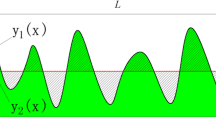Abstract
Most of the theoretical models for surface roughness in finish turning assume that the work piece surface profile is formed by the rounded tip of the tool nose. The effect of the straight flank section in the tool nose region on the surface roughness is usually neglected. In this work, the straight flank section is taken into account in order to predict the arithmetic average roughness R a and root-mean-square roughness R q more accurately. The analytical models for R a and R q are developed as a function of three parameters, namely feed rate, nose radius, and wedge angle. These models were verified using digital simulation method. The surface roughness determined using the new three-parameter models were compared with the existing two-parameter models that consider only the feed rate and nose radius. Decreasing wedge angle was found to lower the surface roughness significantly. An experiment was conducted to test the validity of the three-parameter model at different feed rates in real machining operation. The experimental results agreed more closely with the proposed three-parameter models compared to the two-parameter models.
Similar content being viewed by others
References
Ståhl JE, Schultheiss F, Hägglund S (2011) Analytical and experimental determination of the Ra surface roughness during turning. Procedia Eng 19:349–356
Qu J, Shih AJ (2003) Analytical surface roughness parameters of a theoretical profile consisting of elliptical arcs. J Mach Sci Technol 7(2):281–294
Sung AN, Ratnam MM, Loh WP (2011) Simulation of surface roughness and topography in finish turning using digital image subtraction. IEEE conference on computer applications and industrial electronics conference, Parkroyal Penang Hotel, Penang, Malaysia
Choudhury IA, EI-Baradie MA (1997) Surface roughness prediction in the turning of high-strength steel by factorial design of experiments. J Mater Technol 67:55–56
Lu C, Ma N, Chen Z, Costes JP (2009) Pre-evaluation on surface profile in turning process based on cutting parameters. Int J Adv Manuf Technol. doi:10.1007/s00170-009-2417-9
Suresh PVS, Rao PV, Desmukh SG (2002) A genetic algorithm approach for optimization of the surface roughness prediction model. Int J Mach Tools Manuf 42:675–680
Noordin MY, Venkatesh VC, Sharif S, Elting S, Abdullah A (2004) Application of response surface methodology in describing the performance of coated carbide tools when turning AISI 1045 steel. J Mater Process Technol 145(1):46–58
Wertheim R, Rotberg J, Ber A (1989) Investigation of turning systems where controlled elasticity improves machining performance. J Manuf Technol 38(1):81–85
Groover MP (2010) Fundamentals of modern manufacturing: materials, processes, and systems, 4th edn. Wiley, USA
Sandvik Coromant (2011) Turning tools, Sandvik catalogues.
BS 1134–2 (2010) Assessment of surface texture: guidance and general information, British Standard
Author information
Authors and Affiliations
Corresponding author
Rights and permissions
About this article
Cite this article
Sung, A.N., Ratnam, M.M. & Loh, W.P. Effect of wedge angle on surface roughness in finish turning: analytical and experimental study. Int J Adv Manuf Technol 74, 139–150 (2014). https://doi.org/10.1007/s00170-014-5899-z
Received:
Accepted:
Published:
Issue Date:
DOI: https://doi.org/10.1007/s00170-014-5899-z




